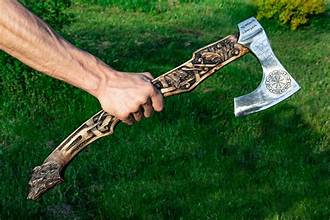
The Viking axe, a quintessential weapon of Norse warriors, stands as a symbol of both practicality and martial artistry. One crucial aspect that defines the effectiveness of a Viking axe is its weight. In this exploration, we will delve into the significance of the weight of Viking axes, understanding how the balance between heft and maneuverability contributed to the success of these iconic weapons on the medieval battlefield.
- Purpose and Design: The Viking axe was a versatile tool, serving various purposes beyond warfare, including woodworking and daily tasks. As a weapon, its design evolved to strike a balance between utility and lethality. The weight of the axe played a pivotal role in determining its effectiveness in combat.
- Varied Weights for Varied Roles: Norse axes were not one-size-fits-all; they came in various shapes and sizes to suit different combat scenarios. The weight of a Viking axe was influenced by its intended use – from the lightweight hand axes used for quick strikes to the heavier, two-handed Dane axes designed for powerful cleaving blows.
- Lightweight Hand Axes: Hand axes, often used for close-quarters combat, were relatively lightweight, typically ranging from one to one-and-a-half pounds. This allowed warriors to deliver swift and precise strikes, capitalizing on speed and agility.
- Medium-weight Battle Axes: Battle axes, designed for more extended reach and versatility, fell into the medium-weight category, generally ranging between one-and-a-half to three pounds. These axes provided a balance between maneuverability and striking power, suitable for a variety of combat situations.
- Heavyweight Dane Axes: The Dane axe, a two-handed behemoth of the Viking arsenal, often weighed between three to six pounds or even more. The added weight contributed to the force behind each swing, making it a devastating weapon against both armored opponents and formations of enemies.
- Balance and Handling: The weight distribution, or balance, of a Viking axe was as critical as its overall weight. A well-balanced axe allowed for better control and maneuverability in the heat of battle. Warriors could effectively adjust their grip and stance, ensuring accurate and powerful strikes.
- Impact on Combat Tactics: The weight of Viking axes influenced the combat tactics employed by Norse warriors. Lighter axes favored quick, agile movements, while heavier axes required a more deliberate and strategic approach, often involving powerful sweeping blows.
- Materials and Construction: The weight of a Viking axe was also influenced by the materials used in its construction. The head, typically made of iron or steel, contributed significantly to the overall weight, while the handle, crafted from wood, helped achieve the desired balance.
- Adaptability and Evolution: Viking warriors were known for their adaptability on the battlefield. The weight of their axes reflected this adaptability, with warriors choosing axes based on the specific challenges presented in a given conflict or campaign.
- Modern Replicas and Practical Considerations: Enthusiasts and historians today often explore the weight of Viking axes through the creation of replicas. Modern recreations consider practical aspects of weight distribution, aiming to capture the essence of these iconic weapons while ensuring safety and usability.


